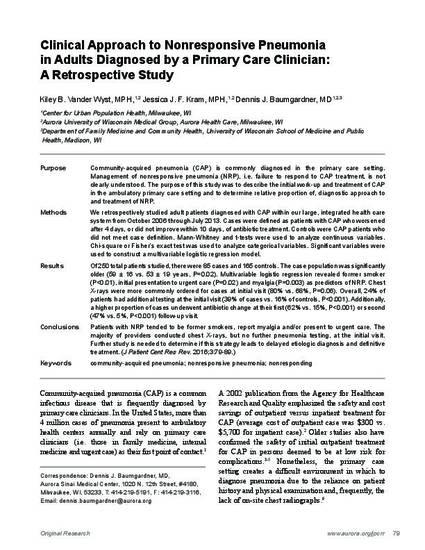
- community-acquired pneumonia,
- nonresponsive pneumonia,
- nonresponding
Purpose
Community-acquired pneumonia (CAP) is commonly diagnosed in the primary care setting. Management of nonresponsive pneumonia (NRP), i.e. failure to respond to CAP treatment, is not clearly understood. The purpose of this study was to describe the initial work-up and treatment of CAP in the ambulatory primary care setting and to determine relative proportion of, diagnostic approach to and treatment of NRP.
Methods
We retrospectively studied adult patients diagnosed with CAP within our large, integrated health care system from October 2006 through July 2013. Cases were defined as patients with CAP who worsened after 4 days, or did not improve within 10 days, of antibiotic treatment. Controls were CAP patients who did not meet case definition. Mann-Whitney and t-tests were used to analyze continuous variables. Chi-square or Fisher’s exact test was used to analyze categorical variables. Significant variables were used to construct a multivariable logistic regression model.
Results
Of 250 total patients studied, there were 85 cases and 165 controls. The case population was significantly older (59 ± 16 vs. 53 ± 19 years, P = 0.02). Multivariable logistic regression revealed former smoker (P < 0.01), initial presentation to urgent care (P = 0.02) and myalgia (P = 0.003) as predictors of NRP. Chest X-rays were more commonly ordered for cases at initial visit (80% vs. 68%, P = 0.06). Overall, 24% of patients had additional testing at the initial visit (39% of cases vs. 16% of controls, P < 0.001). Additionally, a higher proportion of cases underwent antibiotic change at their first (62% vs. 15%, P < 0.001) or second (47% vs. 5%, P < 0.001) follow-up visit.
Conclusions
Patients with NRP tended to be former smokers, report myalgia and/or present to urgent care. The majority of providers conducted chest X-rays, but no further pneumonia testing, at the initial visit. Further study is needed to determine if this strategy leads to delayed etiologic diagnosis and definitive treatment.
Vander Wyst KB, Kram JJ, Baumgardner DJ. Clinical approach to nonresponsive pneumonia in adults diagnosed by a primary care clinician: a retrospective study. J Patient Cent Res Rev. 2016;3:79-89. doi: 10.17294/2330-0698.1211
